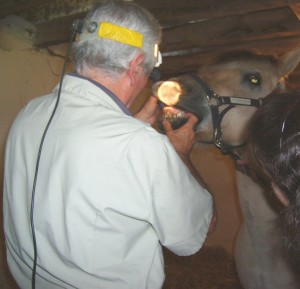“Wild Horses don’t see the Dentist, why does mine have to?”
The answer to this frequently asked question is twofold under the combined heading of ‘Human Interference’.
Our first major interference in the equine mouth is THE BIT.
Wild horses are completely free to walk, trot, canter, gallop, swing their heads and necks to balance, spin, rear and buck with absolutely no restriction on the mouth. Domesticated horses are literally saddled with a seat made of leather on an iron frame, upon which sits a ‘weight’, albeit relatively light, but a discernable weight nonetheless.
In the equines’ mouth is a piece or pieces of steel, plastic, vulcanised rubber, leather, rope, wire, you name it, bits have been made out of it. Attached to which is one or more long thin straps. Holding these straps is the ‘weight’.
Now I’m well aware that your ‘hands’ are as light as a feather, but you would be surprised how many ‘weights’ use these straps rather like the grab-handles on the London Underground Trains to regain their balance and stop themselves falling when their conveyance, train or horse makes a sudden unexpected l
When the bit is forcibly employed it collects large amounts of soft tissue, from the lips, cheeks, tongue and soft tissue within the mouth, collectively known as mucosa and forces this back into a crushing collision with the first molar teeth. If these teeth have sharp points or hooks you may just as well make your bit from barbed wire.
Our second major interference is DIET.
Studies have shown that wild horses graze and browse for on average, 18 hours each day. Their diet is varied and compared to most domesticated horses, is often of much lower nutritional value.
In order to obtain sufficient nutrients, the wild horse eats more and chews it more thoroughly.
Compare the fibrous, stalky grasses of the Prairies, Pampas and Steppes with the lush green sward, soft meadow hay and processed bucket feeds that our domesticated equines eat.
Is it any wonder that domesticated horses have no need to thoroughly masticate their feed? It’s the celery versus banana syndrome.
To extract maximum nutrition, the wild horse chews with a much wider jaw movement. This is known as ‘Mandibular Excursion’. To bring the whole grinding surfaces of the molar tables into action he will swing his lower jaw (mandible) as far as he can. This not only masticates the fibrous food more efficiently it has the effect of keeping the molar surfaces free from the sharp enamel overgrowths that bedevil the domesticated horse.
The domesticated horse only uses 75-95% of the occlusal surface of the molars, always leaving buccal and lingual edges out of occlusion – out of wear, and as the equine tooth permanently erupts to replace natural wear of the enamel surfaces, these unused edges grow into sharp enamel overgrowths.
These overgrowths can cause ulceration to the tongue and cheeks and further restrict the mandibular excursion, compounding the problem.
Just because you can’t see these problems doesn’t mean they aren’t present.
Your horse or pony is a long suffering individual and these are chronic, slow developing conditions and only manifest themselves when the equine is in real distress.
What to look for….
When Eating;
- Dry hay is a good yardstick for dental health.
- Does he get through his entire dry hay ration? Yes; That’s good.
- Does he prefer his hay wet? That’s not so good.
- Does he put his hay in his own water bucket? That’s bad.
- Does he chew mouthfuls of hay, and then spit them out? He’s got a real problem.
- Are his droppings loose (apart from spring grass)? Bad teeth can cause this.
- Whole grains or long fibres in dung mean poor mastication.
Any of the above with weight loss is bad news.
When Ridden;
- Increased bit contact, during transitions, changes of pace and direction causes ears laid back, frightened or angry look in eyes.
- Sudden raising of the head, head shaking, leaning on one rein or stiffness on one or both reins in circles.
- Unable to keep in a collected outline without resistance or apparent discomfort.
- Constant bit chewing and profuse salivation.
- Very strong and pulling, often resulting in mouth bleeds and bit damage.
- Bolting and rearing.
Young equines from two years six months to eight years of age should be examined every six months. From eight to twenty years, every twelve months. Over twenty years every six months.
A competent equine dental practitioner should have a full mouth gag and a good light source to enable a thorough examination of the oral cavity. Plus a full set of molar rasps, picks and forceps. Electric powered instruments are often utilised these days.
You should also be provided with a dental treatment chart, showing the condition of your equines dentition, the treatment that has been carried out together with contact details for the practitioner and his or her qualifications.
Kindly written for ERF by Peter Smith EDT, Equine Dental Services (East Anglia)


